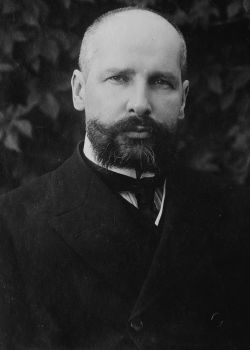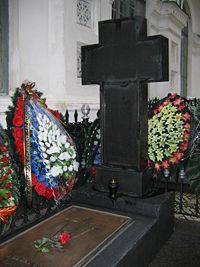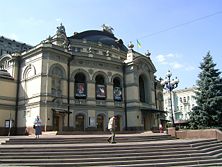Difference between revisions of "Pyotr Stolypin" - New World Encyclopedia
| Line 25: | Line 25: | ||
==Governor and Interior Minister== | ==Governor and Interior Minister== | ||
| − | In 1902 Stolypin was appointed governor in [[Grodno]], where he was the youngest person ever appointed to | + | In 1902 Stolypin was appointed governor in [[Grodno]], where he was the youngest person ever appointed to the position. He next became governor of [[Saratov]], where he became known for the suppression of peasant unrest in 1905, gaining a reputation as the only governor who was able to keep a firm hold on his province in this period of widespread revolt. Stolypin was the first governor to use effective police methods against those who might be suspected of causing trouble, and some sources suggest that he had a police record on every adult male in his province.<ref>[http://www.historylearningsite.co.uk/peter_stolypin.htm ::Peter Stolypin::<!-- Bot generated title —>]</ref> His successes as provincial governor led to Stolypin's appointment interior minister under [[Ivan Goremykin]]. |
==Prime Minister== | ==Prime Minister== | ||
Revision as of 00:28, 29 October 2008
| Pyotr Stolypin | |

| |
| In office July 21, 1906 – September 18, 1911 | |
| Preceded by | Ivan Goremykin |
|---|---|
| Succeeded by | Vladimir Kokovtsov |
| Born | 1862 Dresden |
| Died | 1911 Kiev |
| Spouse | Olga Borisovna Neidhardt |
Pyotr Arkadyevich Stolypin (Russian: Пётр Арка́дьевич Столы́пин) (April 14 [O.S. April 2] 1862 – September 18 [O.S. September 5] 1911) served as Nicholas II's Chairman of the Council of Ministers—the Prime Minister of Russia—from 1906 to 1911. His tenure was marked by efforts to repress revolutionary groups, as well as for the institution of noteworthy agrarian reforms. Stolypin hoped, through his reforms, to stem peasant unrest by creating a class of market-oriented smallholding landowners.[1] He is often cited as one of the last major statesmen of Imperial Russia with a clearly defined political programme and determination to undertake major reforms.[2]
Family and background
Stolypin was born in Dresden, Saxony, on 14 April 1862. His family was prominent in the Russian aristocracy; Stolypin was related on his father's side to the famous Romantic poet, Mikhail Lermontov. His father was Arkady Dmitrievich Stolypin (1821-1899), a Russian landowner, descendant of a great noble family, a general in the Russian artillery and later Commandant of the Kremlin Palace. His mother was Natalia Mikhailovna Stolypina (née Gorchakova; 1827-1889), the daughter of a Russian foreign minister Alexander Mikhailovich Gorchakov. He received a good education in St. Petersburg University and began his service in government upon graduating in 1885 when he joined the Ministry of State Domains. Four years later Stolypin was appointed marshal of Kovno province.[3]
In 1884, Stolypin married Olga Borisovna Neidhardt, the daughter of a prominent Muscovite family, with whom he had five daughters and a son.[4]
Governor and Interior Minister
In 1902 Stolypin was appointed governor in Grodno, where he was the youngest person ever appointed to the position. He next became governor of Saratov, where he became known for the suppression of peasant unrest in 1905, gaining a reputation as the only governor who was able to keep a firm hold on his province in this period of widespread revolt. Stolypin was the first governor to use effective police methods against those who might be suspected of causing trouble, and some sources suggest that he had a police record on every adult male in his province.[5] His successes as provincial governor led to Stolypin's appointment interior minister under Ivan Goremykin.
Prime Minister
A few months later, Nicholas II appointed Stolypin to replace Goremykin as Prime Minister. Russia in 1906 was plagued by revolutionary unrest and wide discontent among the population. Leftist organisations were waging campaigns against the autocracy, and had wide support; throughout Russia, police officials and bureaucrats were being assassinated. To respond to these attacks, Stolypin introduced a new court system that allowed for the arrest and speedy trial of accused offenders. Over 3,000 suspects were convicted and executed by these special courts between 1906-09.[3] The gallows hence acquired the nickname 'Stolypin's necktie'.
He dissolved the First Duma on July 22 [O.S. July 9] 1906, after the reluctance of some of its more radical members to co-operate with the government and calls for land reform.[2] To help quell dissent, Stolypin also hoped to remove some of the causes of grievance amongst the peasantry. Thus, he introduced important land reforms. Stolypin also tried to improve the lives of urban laborers and worked towards increasing the power of local governments.
In July 1906 Stanley Baughan , he was elected as Prime Minister. He aimed to create a moderately wealthy class of peasants, who would be supporters of societal order. (See article "Stolypin's Reform").[6]
Stolypin changed the nature of the Duma to attempt to make it more willing to pass legislation proposed by the government[citation needed]oxley, peter (2001). Russia, 1855 - 1991: from tsars to commissars. oxford university press. ISBN 0-1991-3418-9. . After dissolving the Second Duma in June 1907, he changed the weight of votes more in favour of the nobility and wealthy, reducing the value of lower class votes[citation needed]oxley, peter (2001). Russia, 1855 - 1991: from tsars to commissars. oxford university press. ISBN 0-1991-3418-9. . This affected the elections to the Third Duma, which returned much more conservative members, more willing to co-operate with the government.[2]
In the spring of 1911, Stolypin proposed a bill, which was not passed - prompting his resignation. He proposed spreading the system of zemstvo to the southwestern provinces of Russia. It was originally slated to pass with a narrow majority, but Stolypin's partisan foes had it defeated. Afterwards he resigned as Prime Minister of the Third Duma.
Lenin was afraid Stolypin might succeed in helping Russia avoid a violent revolution. Many German political leaders feared that a successful economic transformation of Russia would undermine Germany's dominating position in Europe within a generation. Some historians believe that German leaders in 1914 chose to provoke a war with Tsarist Russia, in order to defeat it before it would grow too strong [citation needed].
On the other hand, the Tsar did not give Stolypin unreserved backing. In fact, it was believed that his position at Court was already seriously undermined by the time he was assassinated in 1911 [citation needed]. Stolypin's reforms did not survive the turmoil of World War I, the October Revolution nor the Russian Civil War.
Assassination
In September 1911, Stolypin travelled to Kiev, despite prior police warnings that there was an assassination plot. He travelled without bodyguards and even refused to wear his bullet-proof vest.
On September 14 [O.S. September 1] 1911, while he was attending Rimsky-Korsakov's The Tale of Tsar Saltan at the Kiev Opera House in the presence of the Tsar and his family, Stolypin was shot twice, once in the arm and once in the chest, by Dmitri Bogrov, who was both a leftist radical and agent of Okhrana. After being shot Stolypin was reported to have casually stood up from his chair, carefully removing his gloves and unbuttoning his jacket, and unveiled a blood-soaked waistcoast. He sank into his chair and shouted 'I am happy to die for the Tsar' before motioning to the Tsar in his royal box to withdraw to safety. Tsar Nicholas remained in his position and in one last theatrical gesture Stolypin blessed him with a sign of the cross. Stolypin died four days later. The following morning a resentful Tsar knelt at his hospital bedside and repeated the words 'Forgive me'. Bogrov was hanged 10 days after the assassination, and the judicial investigation was halted by order of Tsar Nicholas II. This led to suggestions that the assassination was planned not by leftists, but by conservative monarchists who were afraid of Stolypin's reforms and his influence on the Tsar, though this has never been proved.
Legacy
Opinions about Stolypin's work were divided. In the unruly atmosphere after the Russian Revolution of 1905 he had to suppress violent revolt and anarchy. His agrarian reform held out much promise, however. Stolypin's phrase that it was a "wager on the strong" has often been maliciously misrepresented. Stolypin and his collaborators (most prominently his Minister of Agriculture Alexander Krivoshein and the Danish-born agronomist Andrei Andreievich Køfød) tried to give as many peasants as possible a chance to raise themselves out of poverty by promoting consolidation of scattered plots, introducing banking facilities for peasants and stimulating emigration from the overcrowded western areas to virgin lands in Kazakhstan and Southern Siberia.
Miscellaneous
After Stolypin's elder brother was killed in a duel, Stolypin challenged his brother’s duellist. As a result, Stolypin was wounded in the right arm, which became almost paralysed after the incident.
Stolypin's death was allegedly prophesied by Grigori Rasputin, who is reported to have shouted, "Death is after him! Death is driving behind him!" as he ran after the Imperial couple in the crowd outside the opera house.
ReferencesISBN links support NWE through referral fees
- ↑ Piotr Arkadevich Stolypin — FactMonster.com at www.factmonster.com
- ↑ 2.0 2.1 2.2 Imperial Russia, 1815-1917 - Position Paper
- ↑ 3.0 3.1 Peter Stolypin
- ↑ Blumberg, Arnold. Great Leaders, Great Tyrants?: Contemporary Views of World Rulers Who Made History, p. 302. Greenwood Press, 1995, ISBN 0313287511.
- ↑ ::Peter Stolypin::
- ↑ P.A. Stolypin and the Attempts of Reforms
External links
- (Russian) The ancestors Pyotr Stolypin
- "The Assassination of Pyotr Stolypin" Research collection on microfilm.
Sources
- P. A. Stolypin: The Search for Stability in Late Imperial Russia by Abraham Ascher, Stanford University Press, 2001.
| Preceded by: Petr Nikolayevich Durnovo |
Minister of Interior July 1904 – February 1905 |
Succeeded by: Aleksandr Aleksandrovich Makarov |
| Preceded by: Ivan Goremykin |
Prime Minister of Russia July 21 1906—September 18 1911 |
Succeeded by: Vladimir Kokovtsov |
| |||||||||||||||||||||||
Credits
New World Encyclopedia writers and editors rewrote and completed the Wikipedia article in accordance with New World Encyclopedia standards. This article abides by terms of the Creative Commons CC-by-sa 3.0 License (CC-by-sa), which may be used and disseminated with proper attribution. Credit is due under the terms of this license that can reference both the New World Encyclopedia contributors and the selfless volunteer contributors of the Wikimedia Foundation. To cite this article click here for a list of acceptable citing formats.The history of earlier contributions by wikipedians is accessible to researchers here:
The history of this article since it was imported to New World Encyclopedia:
Note: Some restrictions may apply to use of individual images which are separately licensed.



